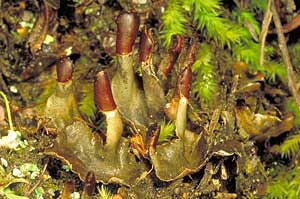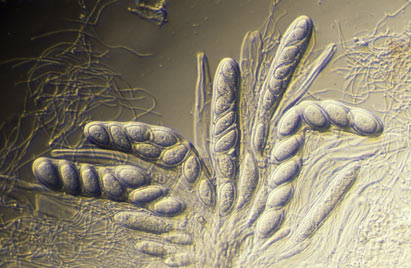
Form and structure
Schneider's book
Albert Schneider's A text-book of general lichenology, published in Binghamton in 1897 by Willard N. Clute & Co. illustrates the structural features of various lichens from the north-eastern United States. In the preface to the book Schneider wrote that it was
...primarily intended as a text-book for the use of students in colleges and universities, but will also be found useful to the specialist...
and that the drawings (with one exception) were
...made by Mr. F. Emil, under the author's supervision. Duly considering the difficulties usually encountered in making drawings of this kind it is believed that they give a fairly accurate presentation of the histological characters...
The drawings in the 76 plates are very clean and neat and I have copied a number of them to help explain some lichen features. There are links to these copies from the relevant sections dealing with lichen structures but you can also get to those illustrations from the links in the list of illustrations below.
Some warnings
Since Schneider's time there have been changes in lichen taxonomy so that a number of the species names he used are no longer appropriate. However, in the captions to the various illustrations I have given only the names used by Schneider and have made no effort to give current species names to Schneider's drawings. It's not always an easy matter to put a modern species name to an older drawing. If you would like to see just what effort could be involved read the ANTARCTIC UMBILICARIA CASE STUDY. That's not to say that all the drawings in Schneider's book would demand that sort of effort. However, while on the subject of Umbilicaria, let's look at the plate of Umbilicaria pustulata in Schneider's book. That species is now known as Lasallia pustulata but it would almost certainly be wrong to so label the drawings. The species is very common in Europe but is at best very rare in North America, where the similar species Lasallia papulosa (once known as Umbilicaria papulosa) is common. A striking difference between the two species is that Lasallia pustulata has coralloid isidia on the thallus whereas these are missing from Lasallia papulosa. These outgrowths are easy to see at low magnification yet the plate in Schneider's book shows no such outgrowths. Almost certainly Schneider had a specimen of papulosa, but thought it was pustulata![]() .
.
It didn't take too long to resolve the identity of the specimen featured in the Umbilicaria pustulata plate of Schneider's book. However, my intent has been simply to let the drawings in Schneider's book illustrate some aspects of lichen structure, so that exactly which species are depicted is not of great importance here. Nevertheless I have given the names Schneider used, should you wish to follow up a particular species in Schneider's book, which you can find online in the Biodiversity Heritage Library.
Another important point is that the drawings are very clean and tidy - and almost too perfect, with none of the untidiness you typically see with a microscope. Since Schneider saw the work largely as a textbook, I suggest you treat the drawings as good, educational diagrams, perhaps slightly stylised (rather than realistic depictions of particular specimens), so as to emphasize the essential structural features in various lichens.
The list of illustrations
Below each link is a brief description of the contents of the associated illustration. Apart from a few exceptions, each of Schneider's plates is devoted to a single species and shows a macroscopic view of the whole lichen as well as cross sections and various microscopic features. In the illustrations linked to below I have generally combined elements from different plates of Schneider's book. So, for example, I have an illustration devoted to transversely septate spores and in that illustration I have copied just the spore drawings from six of Schneider's plates. However, for interest sake, I start this list with a couple of links to full page plates:
Opegrapha varia
A crustose lichen with elongate apothecia (or lirellae).Peltigera canina
The foliose lichen shown in the drawing at the head of this page.Now, the composite illustrations:
flimsy thalli
Some thalli have very little substance to them.thallus variety
These drawings show some of the variety in thallus structure.homoiomerous thalli
Thalli in which the photobiont is distributed more or less uniformly through the thallus.cyphella and pseudocyphella
Two drawings showing the structure of a cyphella and a pseudocyphella.apothecia and perithecia
Some microscopic detail in these fruiting bodies.
asci
Depending on the species, an ascus may contain anywhere from one spore to hundreds of spores.spores - simple or transversely septate
Technically, a simple spore is one that is not divided internally by any cross walls. Transversely septate spores have one or more cross-walls across the shorter dimension.spores - muriform
The word muriform literally means 'wall-like'. Muriform spores have internal cross walls aligned to both the shorter and longer dimensions. When there are many such cross-walls, they give the spore a superficial resemblance to the brick-and-mortar patterning of a brick wall.spores - some more septate forms
A couple of other varieties.
A few notes about Albert Schneider (1863-1928)
During his life Schneider had various interests:
He had the faculty of becoming intensely interested in whatever he took up, unfortunately sometimes to such a degree, that he would lose interest altogether in some former interest, as happened with his interest in lichens. His life, to a certain extent, became a series of interests; first medicine; then botany and especially bacteriology, with its interesting 'Rhizobia'. It was no trouble for him to get interested in lichens, and select lichenology for his Ph.D. thesis; then, again, bacteriology and rhizobia, next pharmacognosy, and last criminology.
A text-book of general lichenology was based on the thesis for his doctoral degree. In 1898 he published A Guide to the Study of Lichens, for those wishing to take up the study of lichens, and over the next few years published a few other papers about lichens![]() .
.
In his later years, when he had become interested in criminology, Schneider developed a word test, to be used in association with a galvanometer (or 'capillary electrometer'), as a means of lie detection. Here is how the test was said to work:
When the examiner uttered a word, the subject was asked to say the first word that came to mind. No questions were asked. When a subject lied, said Schneider, "At the exact fraction of a second in which the subject thus checks his mind, looking for a word which shall not connect him with a crime, the current running to the capillary electrometer is checked, the rising column of mercury stops its climb, and we know that we have found in the man what the psychiatrists call a 'complex'. "At that stage, the operator checked back on the complex, knowing the suspect was concealing something and "further adroit questioning virtually always brings out the truth
."
Form and structure pages on this website Crustose lichens |
![An Australian Government Initiative [logo]](/images/austgovt_brown_90px.gif)



